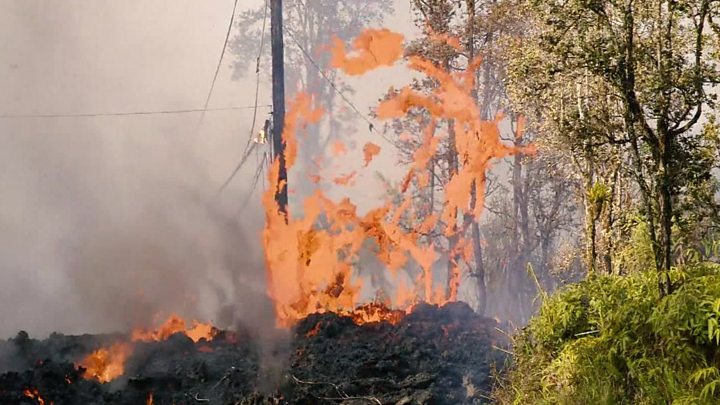
A number of strong earthquakes have hit Hawaii's Big Island, a day after the eruption of the Kilauea volcano.
One 6.9 magnitude quake, south-east of the volcano, was the most powerful to hit the US state since 1975.
It briefly cut power and sent people fleeing from buildings but there was no tsunami warning.
Meanwhile, several fresh eruptions spewed fountains of lava 30m (100ft), destroying several homes and leaving fissures on three streets.
The Civil Defense Agency told any remaining residents to evacuate.
It said there were deadly levels of dangerous sulphur dioxide gas in the air and emergency crews would not be able to help anyone affected.
The new volcanic activity in Mt Kilauea's lower east rift zone amounted to "vigorous lava spattering", the US Geological Survey (USGS) said, adding that additional outbreaks in the area were likely.
The lava was not travelling more than a "few tens of yards" from the vents, which were on streets in the Leilani Estates neighbourhood near Big Island's eastern tip, the USGS said.
However, ground deformation was continuing and there was high earthquake activity in the area, it said. Meanwhile, the level of the lava lake inside the volcano was continuing to drop.
Two homes were destroyed in the latest activity, ABC quoted Hawaii island Mayor Harry Kim as saying.
Maija Stenback, an eyewitness, told the BBC the eruption "was like when someone plays the bass really heavy: you could really feel the power and the lava.
"The colour was unbelievable, and the sound was unbelievable," she said.
"You could hear and feel the eruption a good half a mile away, and the closer you got, the more you could feel it."
But Joyce Jennett, 52, and her husband Roger said they were refusing to leave their home, 1.2 miles (2km) away from the eruption.
"We'll stay until they make us leave," Ms Jennett said.
A spokesperson for Hawaii's Mayor, Janet Snyder, said "elevated levels" of sulphur dioxide were stopping people returning to evacuated areas.
"It is quite toxic and in fact, even our first responders find it too hazardous at this time to go back into the sub-divisions without heavy, protective equipment," she said.
Thursday's eruption prompted a local state of emergency and the mandatory evacuation of 1,700 residents.
Community centres have been opened to provide shelter for evacuees.
Kilauea is one of the world's most active volcanoes and the eruption follows a series of recent earthquakes.
Officials had been warning residents all week they should be prepared to evacuate as an eruption would give little warning.
A volcanic crater vent - known as Puu Oo - collapsed earlier this week, sending lava down the mountain's slopes towards populated areas.
Hawaii's Governor, David Ige, said he had activated military reservists from the National Guard to help evacuate thousands of people.
No comments:
Post a Comment